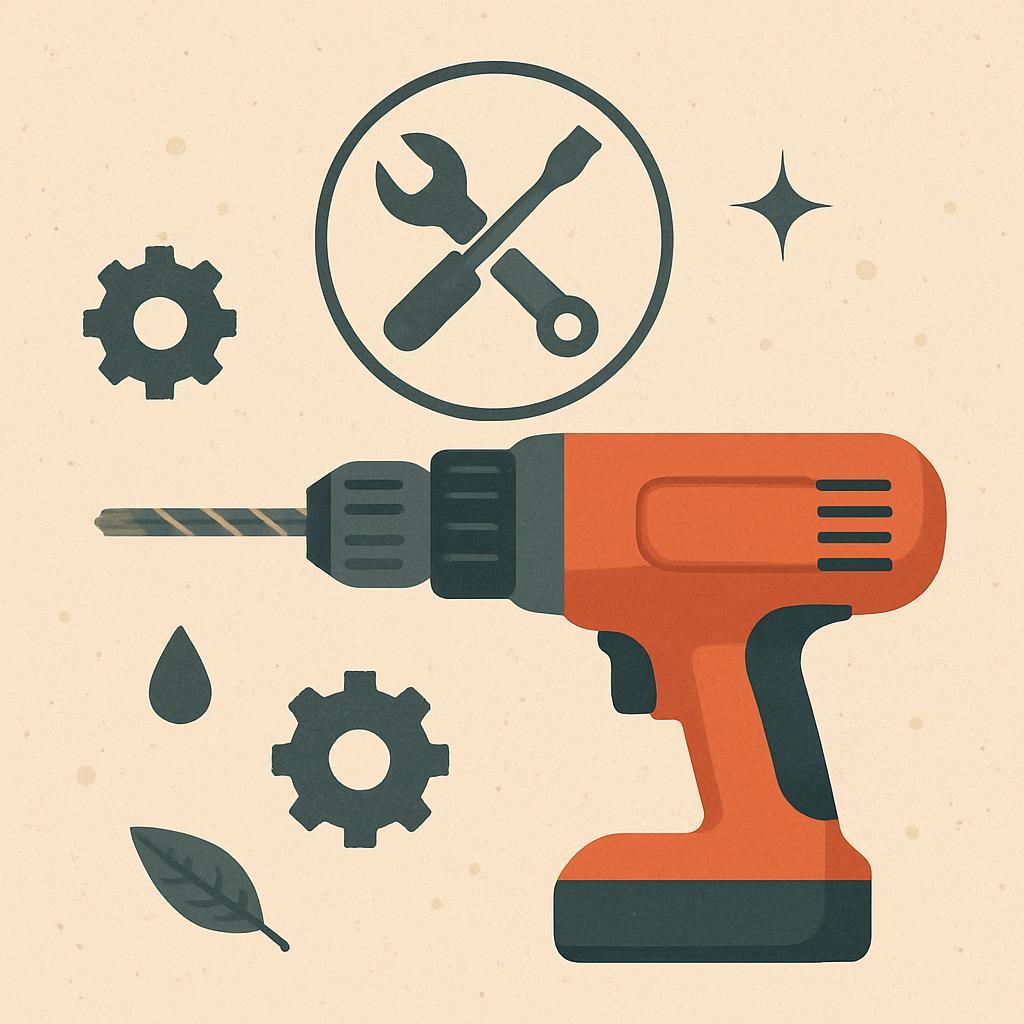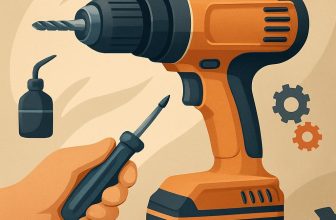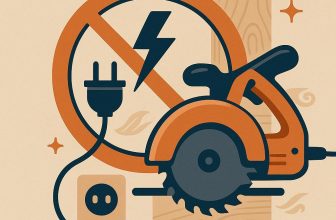
power tools hum with the promise of a perfect cut,yet a neglected spark or squeal can derail a weekend project. Keep Your Power Tools Running Longer shows you how small, steady upkeep adds up to bigger reliability, safer operation, and fewer pricey repairs for woodworkers who love their craft. By embracing a simple routine-cleaning and inspecting, proper lubrication, blade and bit care, battery and charger habits, and smart storage-you'll reduce downtime and extend tool life without chasing gimmicks.You'll learn practical checks you can perform in minutes, how to spot wear before it bites, and ways to choose the right maintenance approach for each tool and project.
Smart Upkeep Practices for Power Tools to extend Lifespan
Regular, light maintenance after each session keeps power tools ready for the next project. wipe the exterior with a dry cloth to capture sawdust and resin, then brush dust from vents, switches, and around the blade or chuck. Inspect blades,bits,and guards for nicks or wear,and make sure the tool is wholly powered off and unplugged (or the battery removed) before any inspection. A quick, gentle clean reduces overheating risk and helps components run smoother for longer.
Preventive checks should be a habit. Inspect cords, plugs, and battery packs for cracks or corrosion, and replace damaged parts promptly. Follow the manufacturer's guidance for lubrication, applying a thin film only where specified and avoiding excess that can trap dust. For cordless tools, store batteries at a cool, dry place with a partial charge if you'll be inactive for a while, and never leave a battery on a charger beyond the recommended time.
Beyond cleaning and lubrication, thoughtful storage and organization reduce wear. Keep tools in a dedicated case or rack, with accessories sorted and always secured. Use protective caps on blades and sanding discs, and unplug cords or store tools off the bench when not in use. by building a simple cadence-clean, inspect, store, and service as needed-you'll lower the odds of unexpected downtime and extend the lifespan of your entire toolkit.
| Cadence | Key Action |
|---|---|
| After each use | Wipe exterior; clear dust from vents; inspect for obvious damage |
| Weekly | Brush vents; clean battery contacts; verify chuck and switch operation |
| Monthly | Check cords and plugs; lubricate only where specified; store with battery at proper state |
| Quarterly | Inspect gearbox (if present); replace worn parts; arrange professional service if needed |
Build Your Dream Workshop on a Budget →
Power Tools Cleaning and Regular Inspections for Reliable Performance
Regular cleaning keeps power tools efficient and safe to use. After each project, unplug the tool and remove any attached battery packs. Use compressed air to clear dust from vents, blades, and gears, then wipe the exterior with a soft microfiber cloth. For stubborn grime, a mild detergent on non-lubricated surfaces is fine, but never spray liquid into the tool's motor housing or switch area. A clean tool runs cooler and signals less risk of overheating during your next job.
Establish a quick visual inspection routine that you perform before every session or weekly, whichever fits your workflow.Look for cracked insulation on cords, damaged plugs, or loose connections. Check battery contacts for corrosion and a secure fit. Inspect the chuck, arbor, and gears for wobble or unusual play, and listen for rattles or grinding when the tool runs. If any safety features (like trigger locks or interlocks) feel unreliable,set the tool aside until it's serviced.
- Inspect power cord and plug for cuts, fraying, or exposed wires.
- Check battery contacts and clean corrosion with a dry cloth or manufacturer-approved cleaner.
- Test switches and safety features for smooth operation.
- Notice any unusual noises or heat during use and stop if something seems off.
Adopt a simple maintenance cadence and protective storage to prolong life. Lubricate moving parts only when the manufacturer specifies and with the recommended product; avoid over-oiling, which attracts dust. Store tools in a dry, elevated location away from extreme temperatures and metal tools that might knock against them. Regular care reduces wear and helps you catch problems early, often saving costly repairs.
| Task | Frequency | What to Check | Signs of Wear |
|---|---|---|---|
| External cleaning | After every use | Exterior surfaces, vents, chuck | Dust buildup; overheating risk |
| Cord & plug inspection | Monthly / before use | Insulation, cracks, fraying | Visible damage; exposed wires |
| Lubrication of moving parts | Every 3-6 months | Bearings, gears, drive interfaces | Dryness; squealing; stiffness |
Build Your Dream Workshop on a Budget →
Power Tools Storage and Handling to Prevent Wear
Smart storage begins with creating a dedicated home for each tool. Keep a dry, dust-free habitat and use wall-mounted racks or labeled cases so every power tool has a secure place.Store accessories like bits, blades, and chargers in their own compartments to avoid metal-on-metal wear and tangled cords. After use, wipe tools down to remove sawdust and moisture, then seal blades or bits in their cases to prevent nicks that degrade performance over time. For added protection, tuck away batteries in a cool spot and consider a small desiccant pack in the cabinet to reduce humidity.
Handling to prevent wear starts with thoughtful use. Choose the right accessory for the job and avoid forcing tools beyond their design limit. Keep cords off the floor and away from sharp edges, and unplug before changing bits or blades to prevent sudden starts. Regularly inspect plugs, switches, and guards for any damage, and keep moving parts clean and lightly lubricated as recommended by the manual. when transporting tools,carry them in padded cases to avoid drops that misalign bearings or gears.
Maintenance routines help tools last longer.Schedule quick weekly checks and a deeper monthly review: clean dust from vents, test batteries, and inspect for loose screws or worn brushes.Replace worn brushes, dull blades, and frayed cords promptly, and store tools at full charge or according to manufacturer guidance for batteries. A simple checklist keeps wear at bay and makes it easier to spot problems before they become costly repairs.
| Item | Why it matters | Best practice |
|---|---|---|
| Cords | Prevent abrasion and safety hazards | Coil loosely; avoid sharp bends |
| Blades/Bits | Maintain edge and precision | Keep sharp; store in guard cases |
| Batteries | Capacity and life | Charge as per manual; avoid full discharges |
| Guards | Safety and longevity | Inspect; replace damaged guards |
Build Your Dream Workshop on a Budget →
Cordless Power Tools Battery and Charging Habits for Longevity
Maximizing cordless power tools longevity starts with the battery itself. Treat packs as a small, sensitive energy reservoir: heat, cold, and voltage surges shorten life. use the charger that came with the kit or a manufacturer-approved option, and keep both battery and tool clean and dry. When you store them, aim for a cool, ventilated spot and avoid piling components in a hot toolbox. A few smart habits can dramatically extend the usable life of your batteries and keep tools ready when you need them.
Charging and usage rhythms matter as much as the hardware.If you can, keep the battery in the 20-80% range for everyday use rather than always pushing to full 100%. Fully charging to 100% occasionally is fine, but frequent full charges add voltage stress that slowly wears cells.After heavy use, let the pack cool before reconnecting a charger, and avoid charging while it's hot. If your environment is warm, remove the battery from the tool after use and store the pack in a cooler spot.
For a quick reference, follow these storage guidelines. The simple table below summarizes best practices at a glance:
| Action | Guidance | Benefit |
|---|---|---|
| storage charge | 40-60% | Stable chemistry during idle periods |
| Storage temperature | cool, dry place (50-70°F / 10-21°C) | slows aging and self-discharge |
| Charger type | OEM or approved charger | Prevents overheating and voltage mismatches |
| Periodic cycles | Occasional 20-40% discharge if gauge drifts | Keeps the indicator accurate and ready |
Ongoing maintenance also pays off. Keep battery contacts clean with a dry, lint-free cloth, and avoid moisture around the terminals. If you have multiple tools, rotate packs to balance wear and reduce heat buildup on any single battery. Inspect packs for swelling or damaged sleeves; a swollen or damaged cell should be retired and replaced.By weaving these habits into your workflow, you'll minimize downtime and maximize the return on every tool you own.
Build Your Dream Workshop on a Budget →
Lubrication and Drive Train Care for Power Tools
Regular lubrication keeps the drive train running smoothly and quietly. In most power tools, the drive train includes bearings, gears, belts or chains, and any pivot points that rotate during operation. Proper lubrication reduces friction, minimizes heat buildup, and slows wear on surfaces that are easy to damage. Begin any service by unplugging the tool (or removing the battery) and consulting the owner's manual for approved lubricants and recommended points to lubricate.
Apply lubrication with a light touch and a clean workspace. Clean the surfaces first to remove dust and grit, then apply lubricant only where surfaces meet. Use a light machine oil to refresh bearings and pivot joints, and reserve grease for gear teeth or enclosed gear housings as directed by the manual-avoid mixing lubricants. Apply sparingly-just a small drop or a thin film-then rotate or run the tool briefly to distribute evenly. wipe away any excess to prevent dust collection and uneven wear.
Choosing the right lubricant depends on the component and enclosure. For exposed bearings and pivots,a thin,fast-drying oil works best; for open gear teeth,a small amount of grease can stay put without migrating elsewhere; for sealed gearboxes,always follow the manufacturer's specification. Avoid heavy greases in places that aren't designed to hold them, and never mix different lubricants. Plan re-lubrication around your tool's duty cycle-after heavy use is a good rule, or every 1-3 months for moderate hobby use. Store tools in a clean, dry place and replace lubricants that show thickening or unusual odors.
| Component | Recommended Lubricant | Submission Tips |
|---|---|---|
| Bearings & pivots | Light machine oil or synthetic tool oil | Apply a drop; rotate to distribute |
| Open gears | Thin grease or gear oil | Apply a light film; wipe excess |
| Sealed gearboxes | Manufacturer-recommended lubricant | Follow manual; do not overfill |
Build Your Dream Workshop on a Budget →
Troubleshooting Common Issues and Building a Simple Upkeep Schedule
Safety first starts every troubleshooting session. If a tool won't start, first disconnect from power and let it cool. Check the obvious: is the cord intact, the plug clean, and the outlet supplying power? For cordless models, swap in a known-good battery and charger to verify the issue isn't a dead pack. Next, inspect for debris or a jam in the moving parts and clear it with a soft brush or compressed air from a safe distance. If the tool overheats, pause and ensure the vents aren't blocked by dust or sawdust so the cooling path stays clear. A quick, careful check can save you from bigger problems and costly repairs.
when problems persist, look for wear and electrical signs. If you hear grinding, notice a burning smell, or the tool trips a safety switch, stop immediately. check the brushes and timing gears where applicable; worn brushes or a slipping drive belt can mimic more serious failures. For cordless tools, inspect the battery contacts for corrosion and clean them with a dry cloth, reseating the pack to ensure a solid connection. Keep liquids away from the housing and use a dry or barely damp cloth for cleaning; moisture can damage electronics and shorten tool life.
To stay ahead of failures, build a simple upkeep schedule with three tiers: daily, weekly, and monthly tasks. Create a quick log so you can track when a part was last serviced and what was replaced. Set reminders in your calendar and store common spare parts within reach. Consistency matters more than intensity: a short end-of-day wipe-down and a quick vent check add up into longer tool life and better performance over time.
| Frequency | Maintenance Task | Notes |
|---|---|---|
| Daily | Wipe exterior; inspect power switch and vents | Keep areas dry and dust-free |
| Weekly | Clean vents; check cords and battery contacts; remove debris | Do not power on while cleaning |
| Monthly | Inspect brushes and belts (if applicable); lubricate moving parts per manual; test safety features | Follow manufacturer guidance |
| Quarterly | Benchmark performance; replace worn components | Consult manual for part numbers |
Build your Dream Workshop on a Budget →
Q&A
How often should I service power tools to keep them running longer?
start with a quick post-use wipe-down and vent check to remove dust.Do a deeper service according to the tool's manual-typically every 6-12 months for light use, and more often in dusty or wet environments. If you notice unusual noise, heat, or reduced performance, address it sooner rather than later.
What routine maintenance steps can I do after each use?
Unplug or remove the battery, then wipe off dust and debris from vents and housings.Check for loose screws or obvious wear on the chuck, guard, and power cord. If the manual calls for lubrication, apply the recommended lubricant to moving parts and avoid over-oiling.
Are there storage practices that help extend tool life?
Store tools in a dry, temperate place and use the original case or a sturdy rack to keep them off the floor. Keep batteries stored at about half charge in a cool, dry spot, and avoid extreme temperatures. Coil cords loosely and protect plugs and ports from dust.
How can I troubleshoot common issues without risking damage?
First, verify the power source-check outlets, cords, and battery charge. Look for obvious signs of wear like frayed cords or damaged plugs, and inspect accessible moving parts for obstruction. If the tool still misbehaves or you're unsure, consult the manual or seek professional service rather than attempting risky fixes.
In Conclusion
Regular upkeep isn't flashy, but it keeps every cut true and every project humming. The key takeaway is simple: cleaning, lubricating, inspecting for wear, and storing tools properly translates into longer life, steadier performance, and fewer interruptions at the bench. For woodworkers, that's not optional-it's a productivity and craft choice that protects investment and fuels creativity. Try applying a quick maintenance ritual to your next project, explore another guide, or adapt the tips to your own tools. With consistent care, your power tools become dependable partners, helping you build with confidence and finish with pride.







Great tips! Regular maintenance really does make a difference in keeping tools in top shape.
Absolutely! I’ve noticed that even small steps like cleaning and lubricating can significantly extend their lifespan. Thanks for sharing!
I completely agree, Susan and Michelle! It’s amazing how just a little attention can prevent major issues down the road. Keeping everything clean and well-lubricated has saved me from costly repairs and replacements!
Totally agree, Ann! It’s incredible how consistent maintenance not only enhances performance but also ensures safety while using our tools. Thanks for highlighting this important topic!
Absolutely, Emma! It’s surprising how much a little routine care can prolong the life of our tools and keep them performing at their best. Thanks for adding to the conversation!
Couldn’t agree more, Jack! It’s so easy to overlook these simple maintenance tasks, but they really do make a world of difference in both performance and longevity. Thanks for sharing!
I totally resonate with all the points made here! Regular upkeep is often overlooked, but it’s essential in extending the life of our power tools and ensuring optimal performance. Thanks for stressing the importance of maintenance!
Absolutely, Cynthia! A little preventive maintenance goes a long way in avoiding bigger problems later. Taking the time to care for our power tools not only keeps them running smoothly but also saves us money in the long run. Thanks for emphasizing this crucial aspect!
I completely agree, Eleanor! Just a bit of regular maintenance can significantly improve both the efficiency and safety of our power tools, and it’s a small investment of time that pays off in the long run. Thanks for reminding us of the importance of upkeep!
So true, Carolyn! It’s amazing how just a few simple checks can save us from costly repairs down the line and ensure our tools are always ready to go when we need them. Thanks for highlighting the significance of proper maintenance!
I couldn’t have said it better, Valerie! Regular maintenance feels like a small effort compared to the huge benefits of longer-lasting and more efficient tools. It’s definitely worth making upkeep a habit!
Couldn’t agree more, Don! It’s often the simplest tasks that make the biggest difference, and investing a little time into maintaining our tools can lead to significant savings and hassle-free usage down the road. Let’s all commit to better upkeep!
Exactly, Olivia! Consistent upkeep is key to ensuring our tools perform at their best and last longer. A few minutes spent on maintenance can really pay off by keeping us productive and avoiding unexpected breakdowns. Great topic!
Absolutely, Christopher! Taking a proactive approach to maintenance not only extends the life of our tools but also enhances their performance, ensuring we get the most out of our investments. It’s definitely a win-win situation!